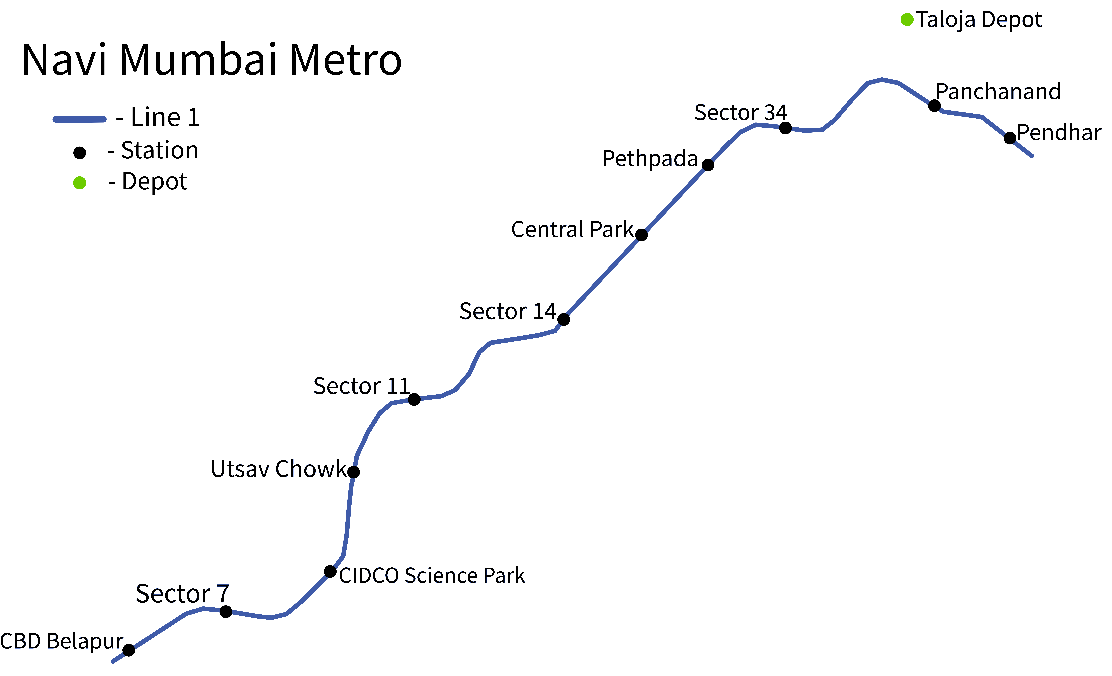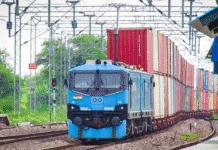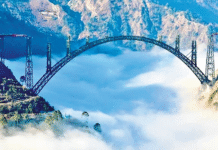Navi Mumbai Metro: An Introduction
Navi Mumbai, created as a satellite city for Mumbai, has grown rapidly in the recent decade. Today, every node, both old and new, that is opening up in Navi Mumbai is being developed carefully with the goal of providing people with cutting-edge social and physical infrastructure. Seawoods Darave, for example, is India’s first and largest transit-oriented development (TOD) situated in Navi Mumbai. The operation of the Navi Mumbai Metro (NMM), which offers good connection to its various nodes, is the next milestone for this satellite city.
Mumbai (Navi Mumbai) Metro Line-1 phase-2 trial run from Central Park (station 7) to Utsav Chowk (station 4) in Kharghar has been completed successfully. With the completion of this successful test, construction on the NMM Line Phase-2 has gained momentum. On November 25, 2022, CIDCO entered into an agreement with ICICI Bank for a Rs 500 crore Line of credit, completing the financial completion process for the Metro Line No. 1 project. With Rs 500 Crore line of credit facility from ICICI Bank, work on Line No. 1 will be hastened, and passengers will be able to ride on this line as soon as the construction is completed on time. The approved line of credit has, in some ways, stamped the trustworthiness of CIDCO’s undertakings.
The Belapur-Pendhar line viaduct has been finished, and 5 of the 11 stations are ready for commissioning. This Line has received all necessary certifications, including CMRS. The last six stations are now under construction, and the entire route is projected to be operational very soon. The cost of Metro line-1 is anticipated to be around Rs 3,400 crore, of which Rs 2,600 crore has already been invested by CIDCO, Rs 500 crore is from a bank line of credit, and the remainder would be CIDCO internal accruals.
The Navi Mumbai Metro is expected to serve one lakh passengers per day by 2027. After receiving the RDSO certificate and the ‘Dynamic Clearance Certificate,’ the next step for the Navi Mumbai Metro was to obtain the Commissioner of Metro Railway Safety (CMRS) certificate. On February 11, 2022, the Railway Board of the Government of India approved the rolling stock (coaches, electricity, etc.) of CIDCO’s Navi Mumbai metro. The Navi Mumbai Metro is now undergoing civil work inspection. Following the successful completion of the civil work inspection, the CMRS and the Railway Board will issue a green signal to begin direct transport.
Metro Rail Network
The Maharashtra government has designated the City and Industrial Development Corporation of Maharashtra Ltd (CIDCO) as the implementing agency for the building, maintenance, and operation of the Navi Mumbai Metro Corridor-1, which will be built in three stages. On May 1, 2011, the foundation stone for the Navi Mumbai metro train project was laid. Corridor-1 connects Belapur, Kharghar, Pendhar, Kalamboli, and Khandeshwar, with plans to expand it to Navi Mumbai International Airport (NMIA). Corridor-1 is based on a detailed project report prepared for the Navi Mumbai Metro Rail Project by the Delhi Metro Rail Corporation (DMRC).
Metro Line 1
Line-1 will be 23.4 kilometres long and will have 20 metro stations. The Navi Mumbai Metro Line 1 line will begin in Belapur and end at the Navi Mumbai International Airport (NMIA). Line-1 would be built in four phases, with the first covering a distance of 11.10 kilometres and include 11 elevated stations with a terminus at Belapur and a depot-cum-workshop at Taloja metro station.
Metro Line 2
The Navi Mumbai Metro Phase 2 route from MIDC Taloja metro station to Khandeshwar will stretch 10.30 kilometres and feature eight stops. The Navi Mumbai Municipal Corporation (NMMC) and the Mumbai Metropolitan Region Development Authority (MMRDA) will fund Navi Mumbai Metro Lines 2 and 3, respectively.
A two-kilometre-long interlink between Pendhar and MIDC will be developed as part of Phase 3 of the Navi Mumbai Metro line. Ultimately, Phase 4 of the Navi Mumbai Metro will run from Khandeshwar to the Navi Mumbai International Airport (NMIA).
Metro link to suburban railway stations
Belapur suburban railway station would be connected to Metro station 1, while Kharghar suburban railway station would be connected to Metro station 3. Furthermore, the Taloja metro station could provide as a link to the Konkan Railway. The Navi Mumbai Metro would be a three-car train that could be expanded to a six-car train if demand grows and related infrastructure becomes available.
Dynamic Clearance Certificate
Mumbai (Navi Mumbai) The central Ministry of Telecommunications granted the ‘Dynamic Clearance Certificate’ to Metro Phase 1 from Belapur to Pendhar metro station.
RDSO Certified
The interim speed certificate for CIDCO’s Navi Mumbai Metro’s Metro Line-1, Phase 1, from Belapur to Pendhar metro station has been given by the Research Design and Standards Organisation (RDSO) in Lucknow. The RDSO certificate for the Navi Mumbai Metro route between stations 7 and 11 was issued on October 20, 2021. Navi Mumbai Metro received the certificate following successful trials and reviews of test certifications, as well as a vast quantity of documentation demonstrating adherence to the RDSO safety rules.
Conclusion
The Navi Mumbai Metro is a mass rapid transit system built by CIDCO, with line 1 set to open in early 2023. To relieve the strain on the railway network and the increasing traffic on the roads, a new method of public transportation was needed to connect all Navi Mumbai residential nodes. As a result, the Navi Mumbai metro was constructed with five lines that span 106.4 kilometres. The Navi Mumbai Metro will not only meet a critical transit necessity for the smart city, but it will also help the city’s economic growth.








Central and State Governments owe a lot to Mumbaikar’s. As they are most Hardworking people in the World. On average a Mumbaikar Travels 20-30 Kms . more world Class Infrastructure is Needed for Mumbai and MMR Region. As This Region is Growing Rapidly each passing Day. and Only Better’ Connectivity will Ease The pain of Traveling, Jobs, Housing, Education, Ease of Living etc. And We are are Highest Revenue Generator in all of India
Central and State Governments owe a lot to Mumbaikar’s. As they are most Hardworking people in the World. On average a Mumbaikar Travels 20-30 Kms . more world Class Infrastructure is Needed for Mumbai and MMR Region. As This Region is Growing Rapidly each passing Day. and Only Better’ Connectivity will Ease The pain of Traveling, Jobs, Housing, Education, Ease of Living etc. And We are are Highest Revenue Generator in all of India
Pl commission the route early as the project already delayed ..we are eagerly awaiting the commencement of service for a long time
Was delighted to find this article on Navi Mumbai Metro. However, at the end felt disheartened on getting no trace of any possibility to link Navi Mumbai to Mumbai through Metro. Unless, such important efforts are made, Navi Mumbai will be deemed to be a separate island, even to Mimbaikars.
Will the metro link to navi mumbai airport be ready at the time of the airport inauguration. CIDCO is a lousy organisation. Even the construction of metro-8 not yet started. For what is MMRDA waiting ?